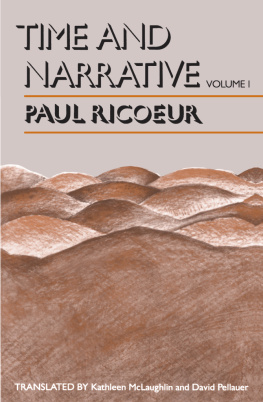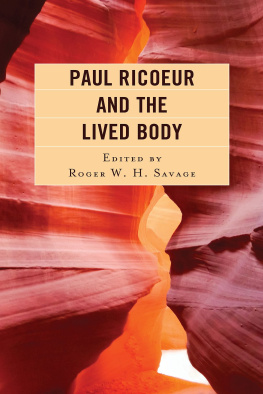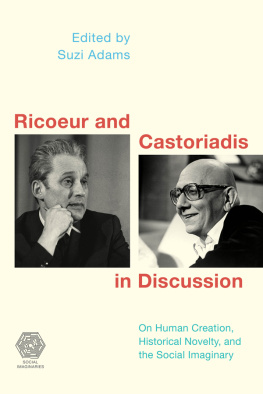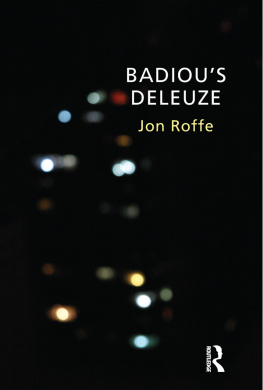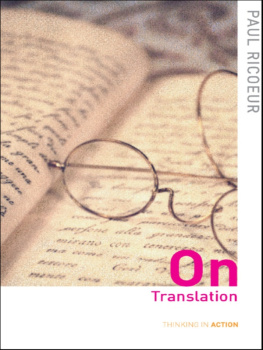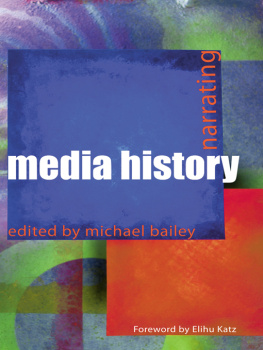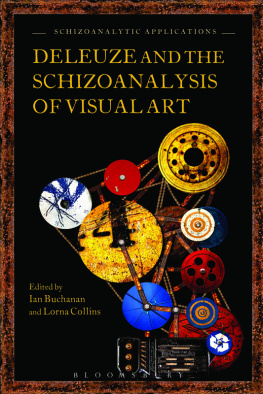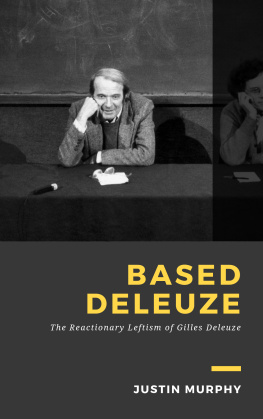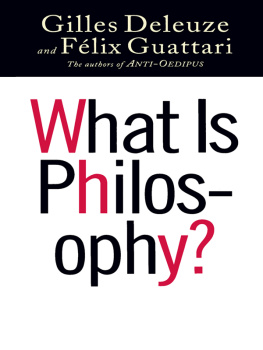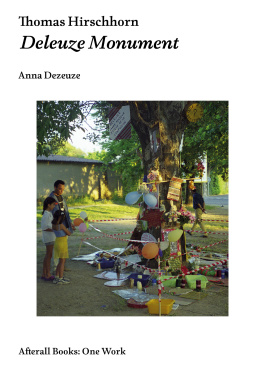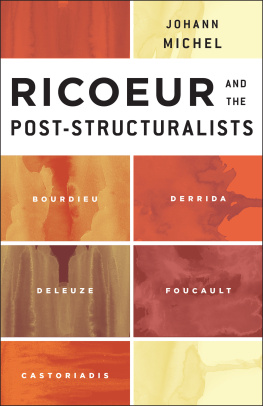Saorsa - Narrating the Catastrophe: An Artist’s Dialogue with Deleuze and Ricoeur
Here you can read online Saorsa - Narrating the Catastrophe: An Artist’s Dialogue with Deleuze and Ricoeur full text of the book (entire story) in english for free. Download pdf and epub, get meaning, cover and reviews about this ebook. year: 2011, publisher: Intellect Books, genre: Religion. Description of the work, (preface) as well as reviews are available. Best literature library LitArk.com created for fans of good reading and offers a wide selection of genres:
Romance novel
Science fiction
Adventure
Detective
Science
History
Home and family
Prose
Art
Politics
Computer
Non-fiction
Religion
Business
Children
Humor
Choose a favorite category and find really read worthwhile books. Enjoy immersion in the world of imagination, feel the emotions of the characters or learn something new for yourself, make an fascinating discovery.

Narrating the Catastrophe: An Artist’s Dialogue with Deleuze and Ricoeur: summary, description and annotation
We offer to read an annotation, description, summary or preface (depends on what the author of the book "Narrating the Catastrophe: An Artist’s Dialogue with Deleuze and Ricoeur" wrote himself). If you haven't found the necessary information about the book — write in the comments, we will try to find it.
Saorsa: author's other books
Who wrote Narrating the Catastrophe: An Artist’s Dialogue with Deleuze and Ricoeur? Find out the surname, the name of the author of the book and a list of all author's works by series.
Narrating the Catastrophe: An Artist’s Dialogue with Deleuze and Ricoeur — read online for free the complete book (whole text) full work
Below is the text of the book, divided by pages. System saving the place of the last page read, allows you to conveniently read the book "Narrating the Catastrophe: An Artist’s Dialogue with Deleuze and Ricoeur" online for free, without having to search again every time where you left off. Put a bookmark, and you can go to the page where you finished reading at any time.
Font size:
Interval:
Bookmark:
Narrating the Catastrophe
For Alan, India and Finn my family
Narrating the Catastrophe
An Artists Dialogue with Deleuze and Ricoeur
Jac Saorsa

intellect Bristol, UK / Chicago, USA
First published in the UK in 2011 by
Intellect, The Mill, Parnall Road, Fishponds, Bristol, BS16 3JG, UK
First published in the USA in 2011 by
Intellect, The University of Chicago Press, 1427 E. 60th Street,
Chicago, IL 60637, USA
Copyright 2011 Intellect Ltd
All rights reserved. No part of this publication may be reproduced,
stored in a retrieval system, or transmitted, in any form or by
any means, electronic, mechanical, photocopying, recording, or
otherwise, without written permission.
A catalogue record for this book is available from the
British Library.
Cover designer: Persephone Coelho
Copy-editor: Macmillan
Typesetting: Mac Style, Beverley, E. Yorkshire
ISBN 978-1-84150-460-5
Printed and bound by Gutenberg Press, Malta.
Contents
Introduction: first words The journey begins A meaningful psychosis What is philosophy? What is art? The nature of the concept The concept visualised What is science? The pre-eminence of the rhizome over the metaphor Root, stem and rhizome 1st Articulation The rhizome as a conceptual construct: map and tracing
The Text and the Other Language Hermeneutics Edmund Husserl (18591938) Martin Heidegger (18891976) Hermeneutics and Visual Understanding Hans George Gadamer (19002002) Paul Ricoeur (19132005)
Drawing on Conversation: Introduction The relevance and irrelevance of language Textual bilingualism Interlanguage Structure and the interpretation of the text Depth From looking to seeing: Alice and the architectural illusion Narrative identity and The Idiot
Documenting the Stone: The artists voice Practice and process: i: a passion for the line ii: process and its histories iii: the phenomenographical stone iv: the drawing act v: time, movement, becoming, cause, effect and confatalia The shift: structure to figuration.
Head: Revisiting the shift: from figuration towards structure Sensation Love in two- dimensions Superficial anatomy Anatomical architecture The consequence of the heart Autoethnography: the echoing artists voice
Amputee: In the valley of interpretation An artist for scientists, a scientist for artists Reflexion, interpretation appropriation Reflexive philosophy, narrative identity and the teleological context Time, self, and appropriation beyond narrative Representation, figuration and the figure: a folded text
The Dyer Drawing: Circling the Figure (Authors note) Introduction The Dyer drawing and the drawing act John Deakin Deakin and Muybridge: subject, object, form, function Moving towards sensation Practice: through which the child becomes the man An autoethnographic account The Diagram The Catastrophe Rhythm The Body Without Organs Exit the artist
Introduction The hermeneutic circle The Deleuzean Refrain Shadows of the Self and the eternal paradox: The autoethnographic trap Last words The interpretive journey of Narrating the Catastrophe
List of Illustrations
Preface
Who?
I n his last book, Essays Critical and Clinical, Gilles Deleuze refers to an invented foreign language that runs beneath the original English in Melvilles classic, Moby Dick (or The Whale). This language is OUTLANDISH or Deterritorialised, the language of the Whale (1998: 72, original capitals). For Deleuze, whale language demonstrates how conventional language can be pushed outside its own limits towards an eloquent silence, and it confirms further that the book an author writes is always the inverse of another book that could only be written in the soul, with silence and blood (1998: 72). As the author of the present book, I orchestrate the dialogue that is Narrating the Catastrophe, but at the same time, as the artist who has created the works that make up the visual content, I am also a fully involved participant in its exploration of a rhizomic interaction between visual art practice, autoethnographic account and academic discourse. The intertextual nature of the text therefore becomes intratextual, through the capacity of my self-reflexive approach to reveal the complexities of the relation between content and expression. In this way, the book does indeed come as much from the soul as from the ink.
Narrating the Catastrophe constitutes a hiatus in a perpetual journey, a moment of respite in an ongoing passage through time and inclination. It is a conflation of visual art practice and philosophical discourse, a narrative of a journey through unfamiliar landscapes of becoming where Being is defined as act rather than form. I am an artist and philosopher, or at least I call myself these things at the same time as I am fascinated by the exploration of the ways in which we understand ourselves as existing in, and establishing meaningful relations with, the world around us. This is the world that is silent, tasteless and odourless, and within which we are deaf, dumb and blind until we discover meaning through our senses, and are discovered in turn by meaning. This is the world in which I have travelled four decades and more, always driven towards unfamiliar territories by an inescapable engagement with practice and an enduring philosophical concern with the relationship between the art and meaning.
Why?
In writing this book I have climbed to the edge of a high, exposed plateau, from where I can look out over the textual landscape below as it spreads wide across a vast flat plane. (The reason for my use of the term plane here instead of the more immediately appropriate plain will, I hope, become apparent as you move further into the text.) Over the plane I see other plateaus on distant horizons, the horizons that I have already made, and am yet to make for myself in my travels as an artist. Their reality on the plane demonstrates that Narrating the Catastrophe is not the end of a journey but rather a significant connection on the way, a multiplicity that acts as a primary locus of interrelation between other plateaus, other multiplicities that must always occur where art practice and philosophy meet. As I look out over the plane it occurs to me that I have written this book many times before, and in many different ways, and there are yet many more ways, always more besides, and even within.
What?
Narrating the Catastrophe is a philosophical discourse based on the exploration of elements and dimensions of figuration in visual art, as manifested in my own creative drawing practice. The discourse is written in the form of a dialogue between myself and two giants of contemporary French philosophy, Gilles Deleuze and Paul Ricoeur. As an artist, the conceptual philosophical framework that Deleuze constructed, both alone and with Felix Guattari, and most especially as it is expressed in his aesthetics, has long since influenced me. Moreover, my fascination with his work has deep roots in my appreciation of the wider context within which it is situated, that of Continental philosophy. This is of course the same context within which Ricoeur is also a major contributor.
The existence of this wider philosophical context is testimony to the perhaps quite obvious principle that nobody works in a vacuum, and as such, both Ricoeur and Deleuze have their own influences, as well as their own ideas and reservations about each others work. Sheerin confirms how Ricoeur for example, acknowledges Deleuzes work on Nietzsche, and Deleuze, in turn, praises Ricoeurs concept of the aborted cogito (Sheerin 2009: 4). But, despite certain mutual precedents, neither directly influences the other in any acknowledged way, and indeed, their respective conceptual frameworks can quite easily be understood as demonstrating insurmountable differences. My aim in bringing them together here, however, is not so much to provide an explication of their conflicting views, much less to produce a fulsome interpretation of their works as a whole, but rather to demonstrate how their differing passions in relation to the concept of self-understanding through interpretation may, together with my own autoethnographic account, create a synthesis of ideas that extends our understanding of the nature of understanding, and even create conditions from which new understandings can emerge. On a journey through this text therefore, part of the task of developing a meaningful understanding of our own way of being-in-the-world in relation to the content that draws primarily on respective formulations of both these key thinkers must be to acknowledge their potential connections, as well as their obvious differences. Only in this way will we encounter them, if not on an equal footing, at least on level ground. Only in this way can we interpret and communicate on the multiple levels necessary for the ensuing dialogue to become a creative and self-generative construction in which objective intellect and subjective emotion are of equal status and mediated in their relation by the text itself.
Next pageFont size:
Interval:
Bookmark:
Similar books «Narrating the Catastrophe: An Artist’s Dialogue with Deleuze and Ricoeur»
Look at similar books to Narrating the Catastrophe: An Artist’s Dialogue with Deleuze and Ricoeur. We have selected literature similar in name and meaning in the hope of providing readers with more options to find new, interesting, not yet read works.
Discussion, reviews of the book Narrating the Catastrophe: An Artist’s Dialogue with Deleuze and Ricoeur and just readers' own opinions. Leave your comments, write what you think about the work, its meaning or the main characters. Specify what exactly you liked and what you didn't like, and why you think so.

